
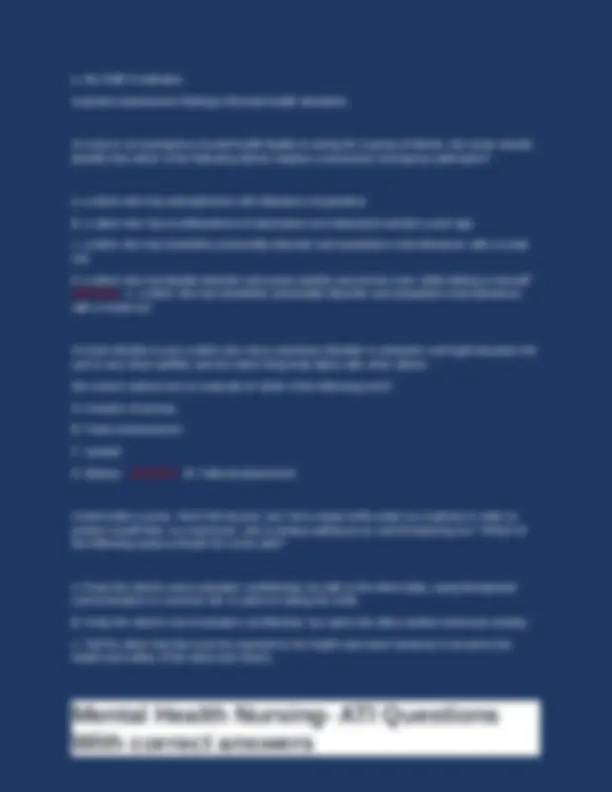
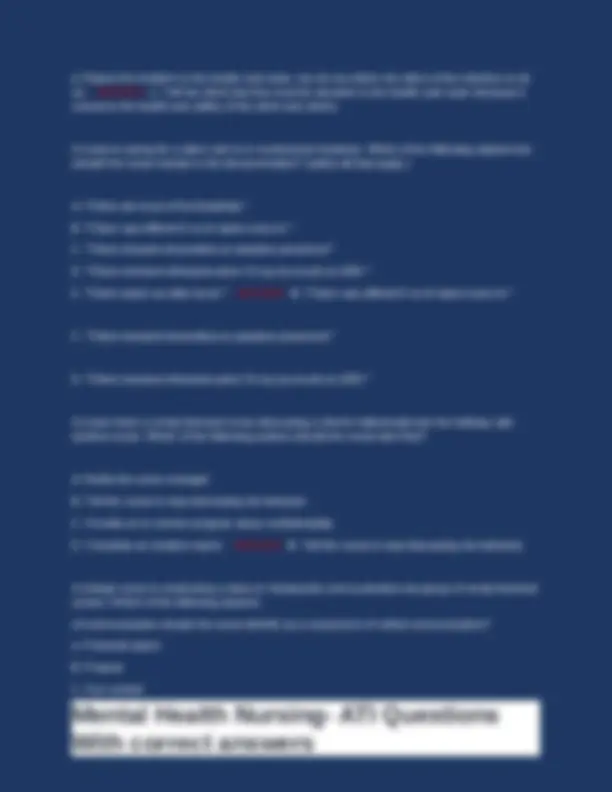
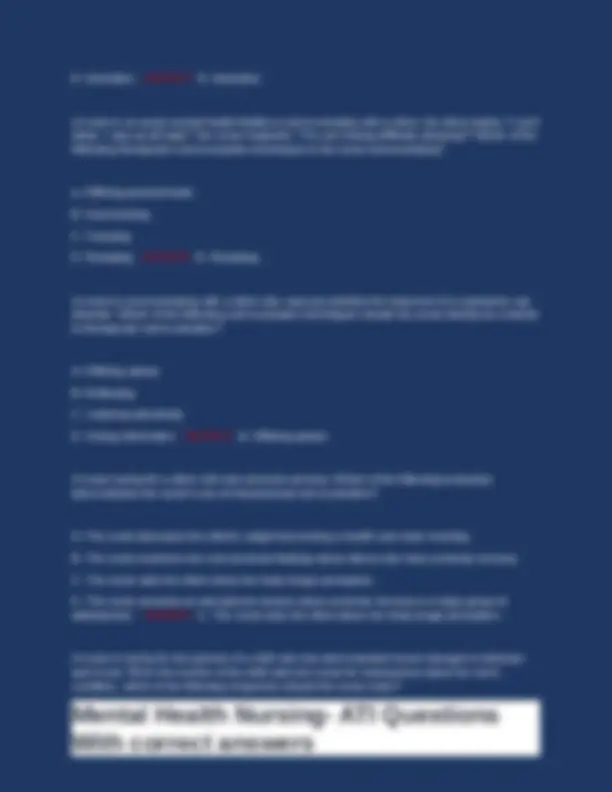
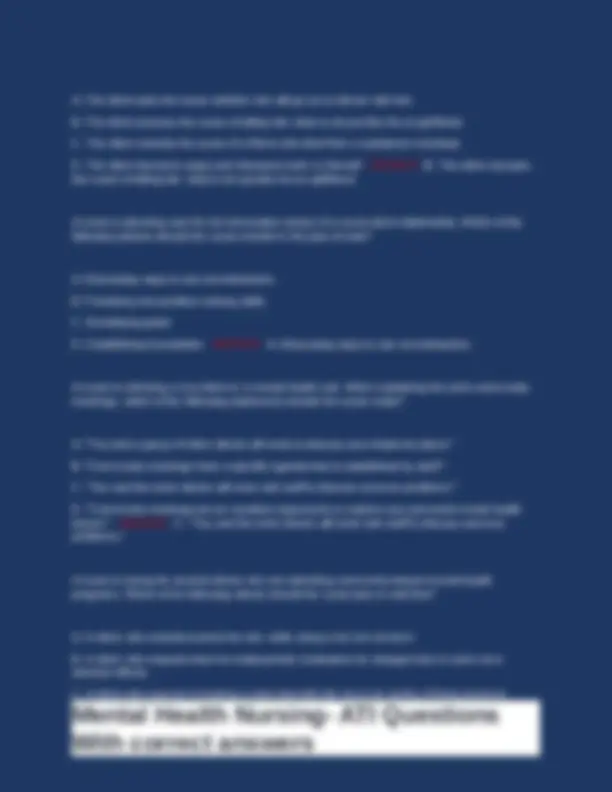
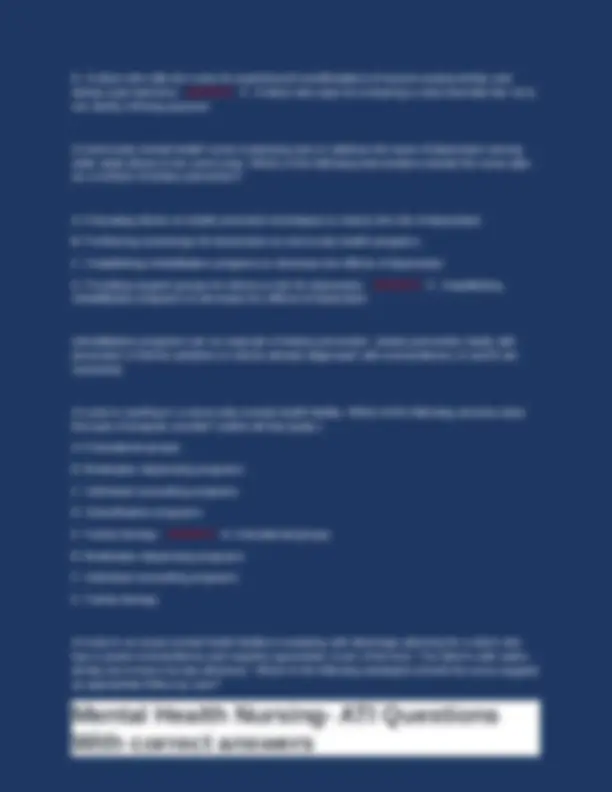
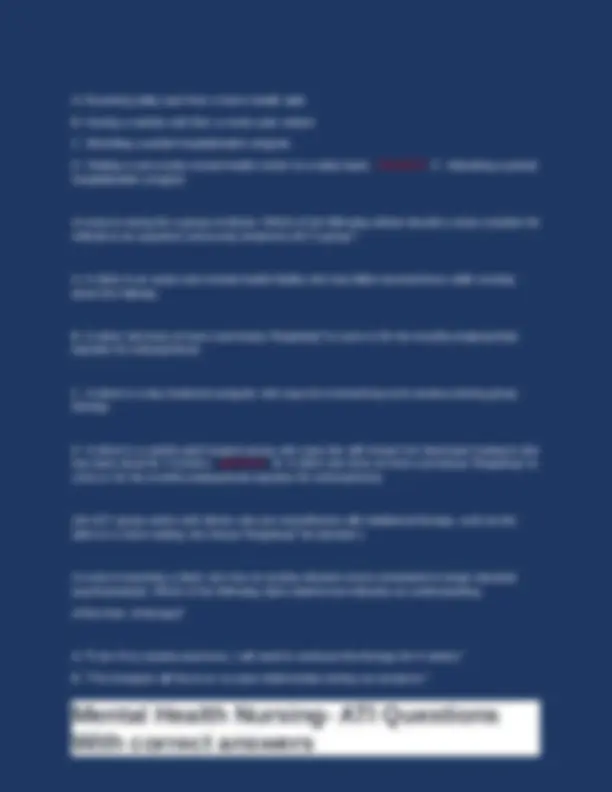
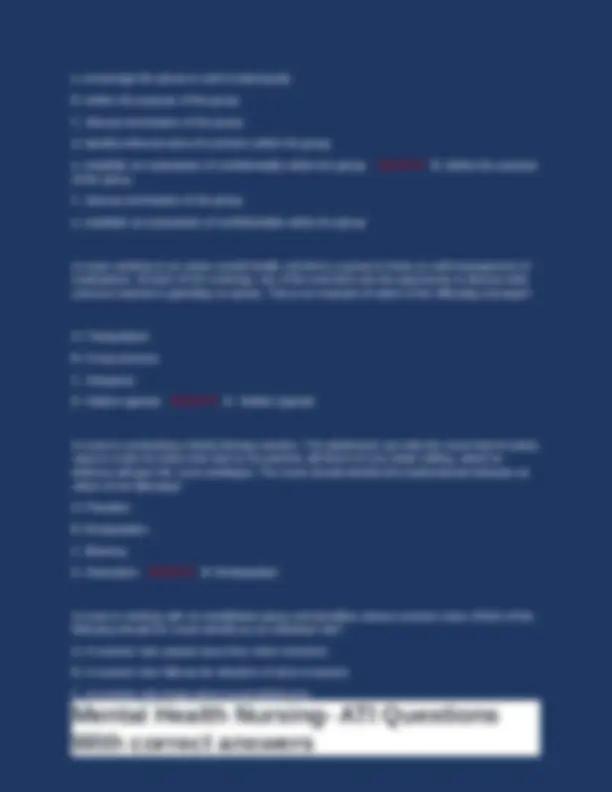
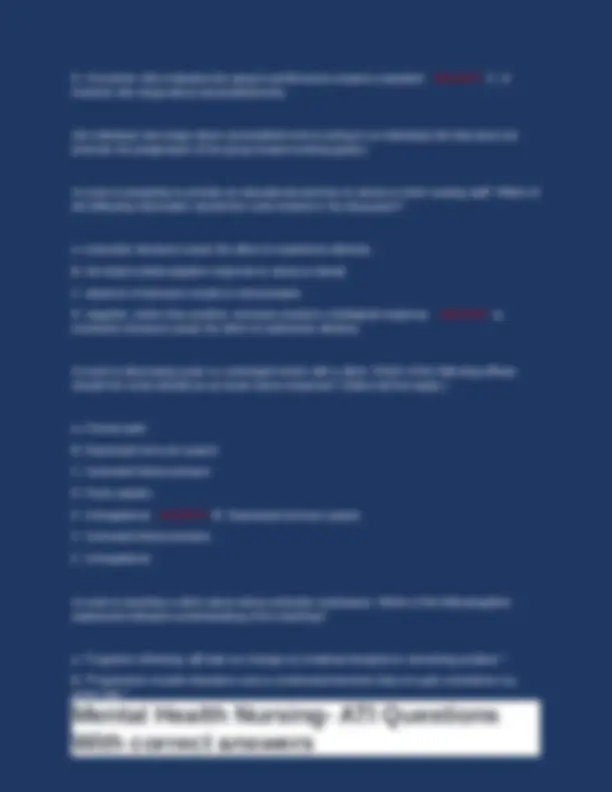
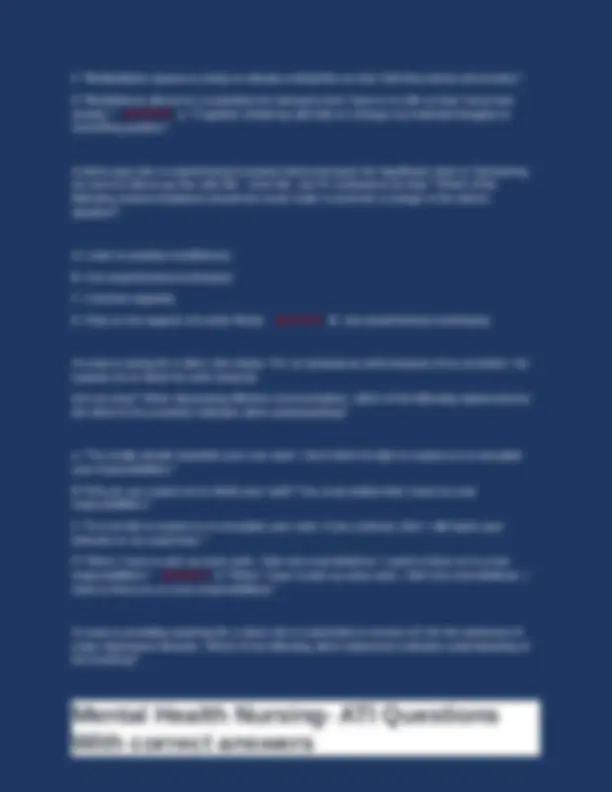
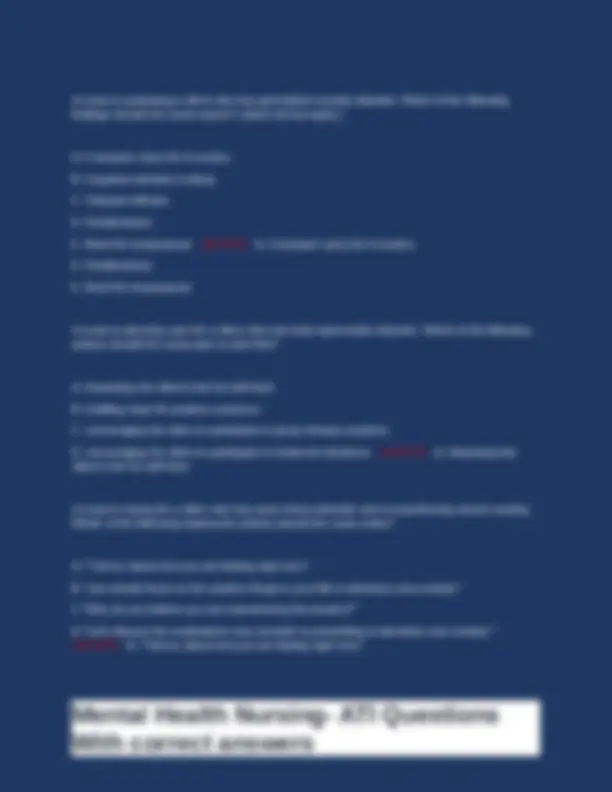
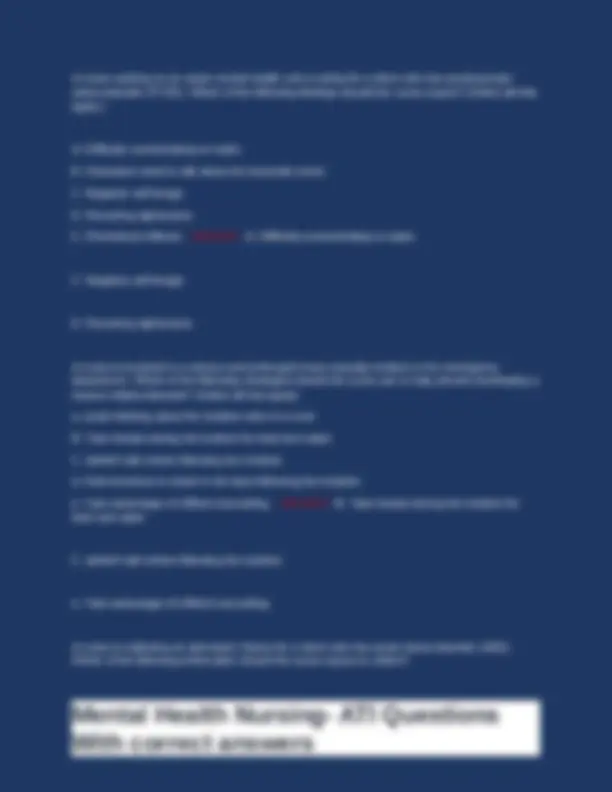
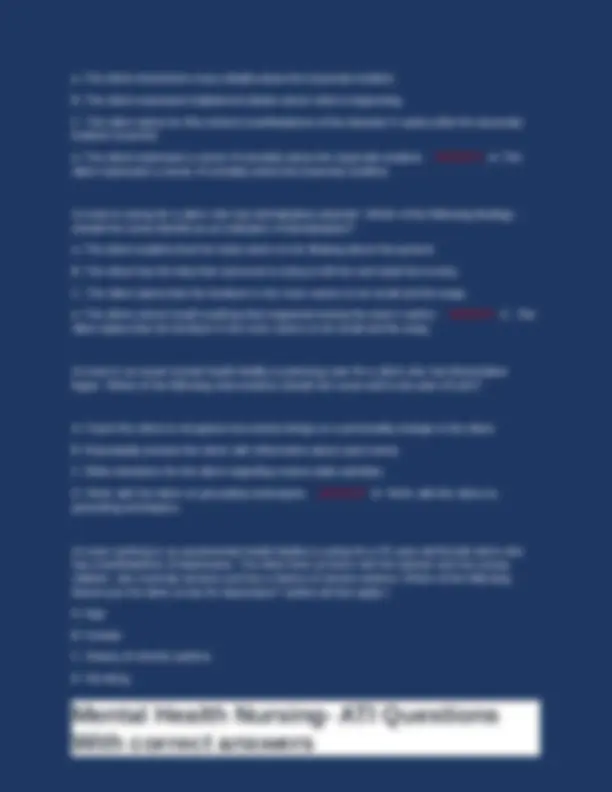
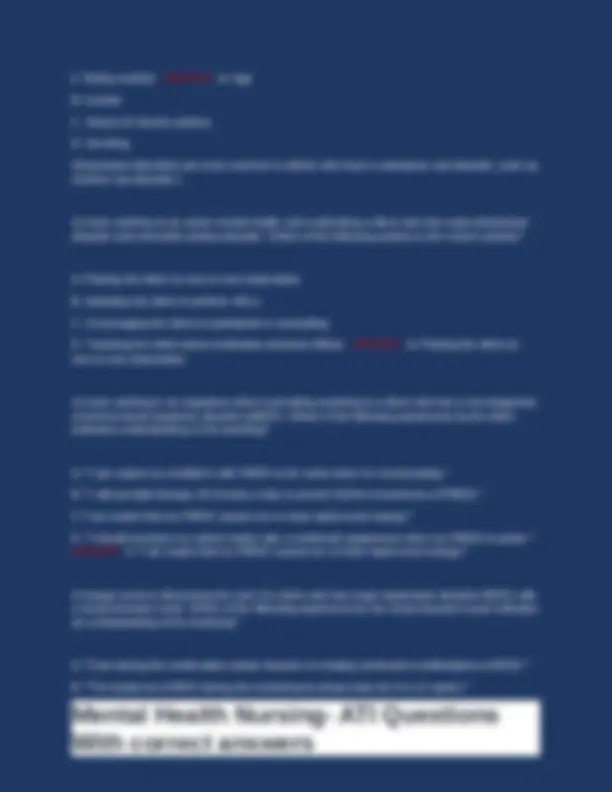
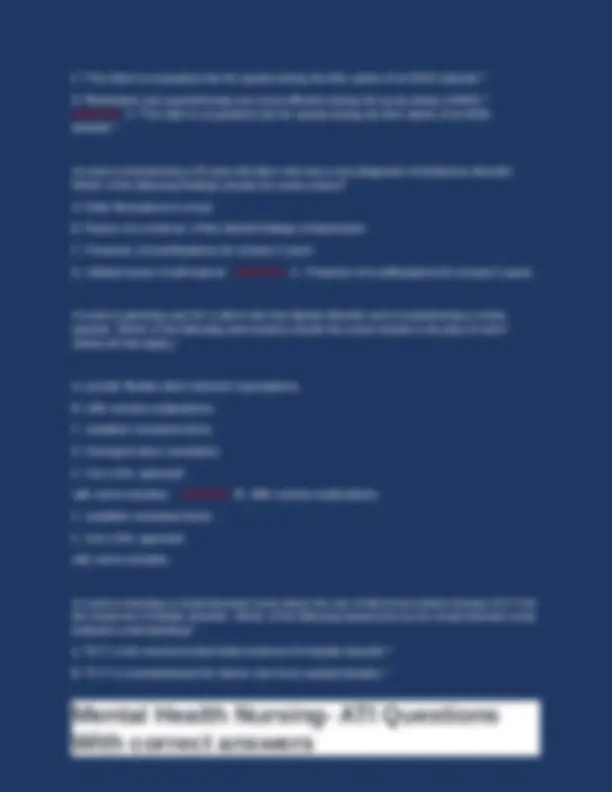
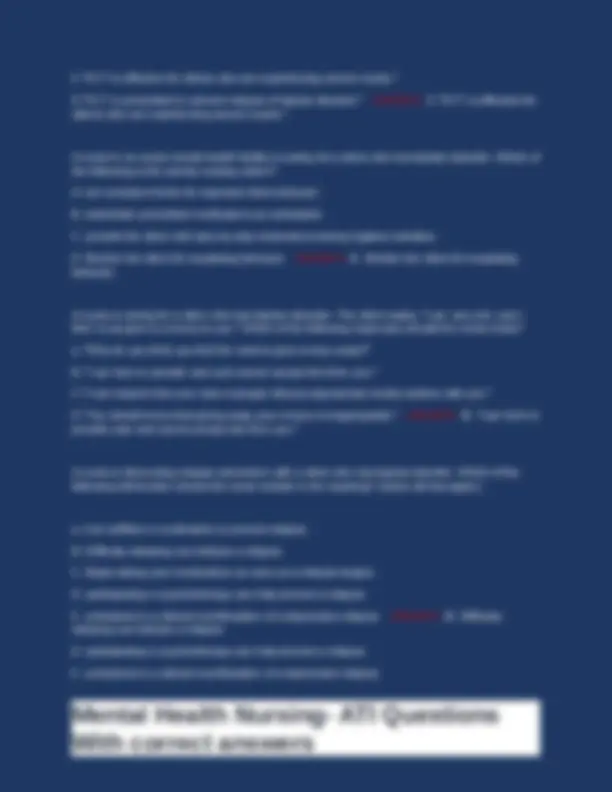
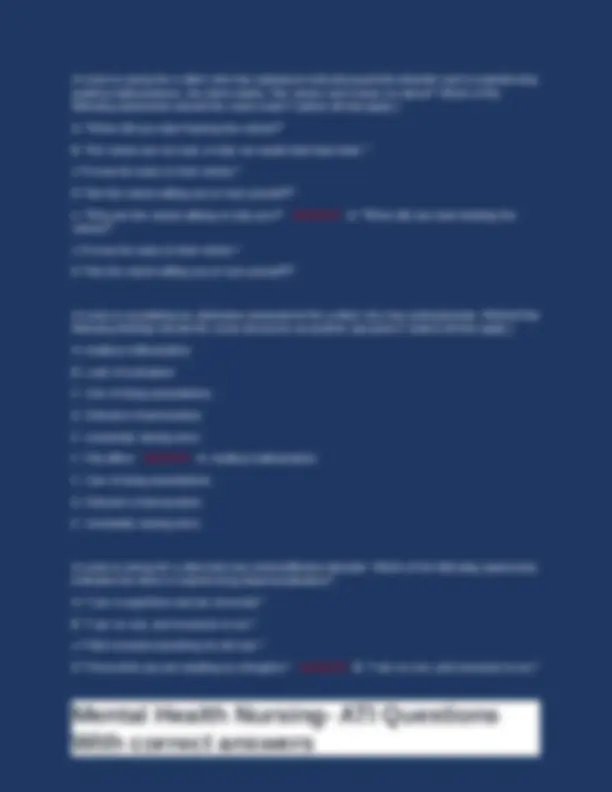
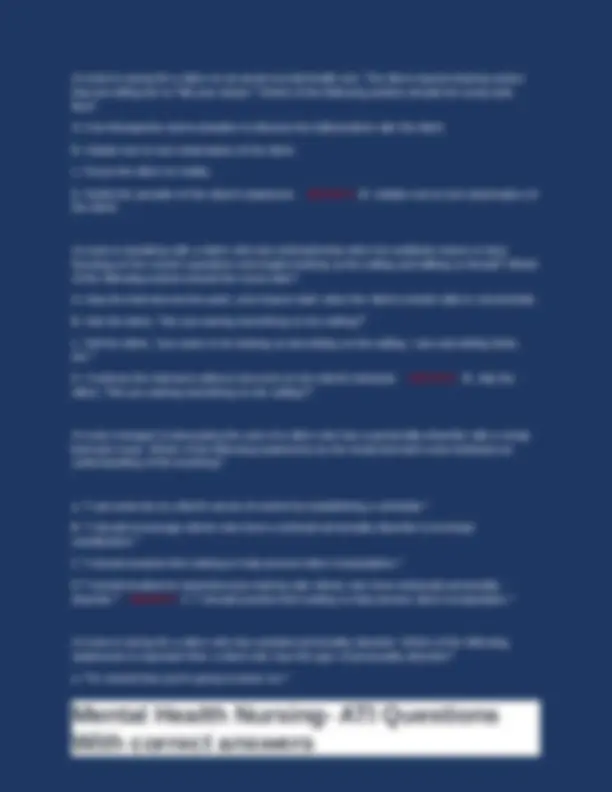
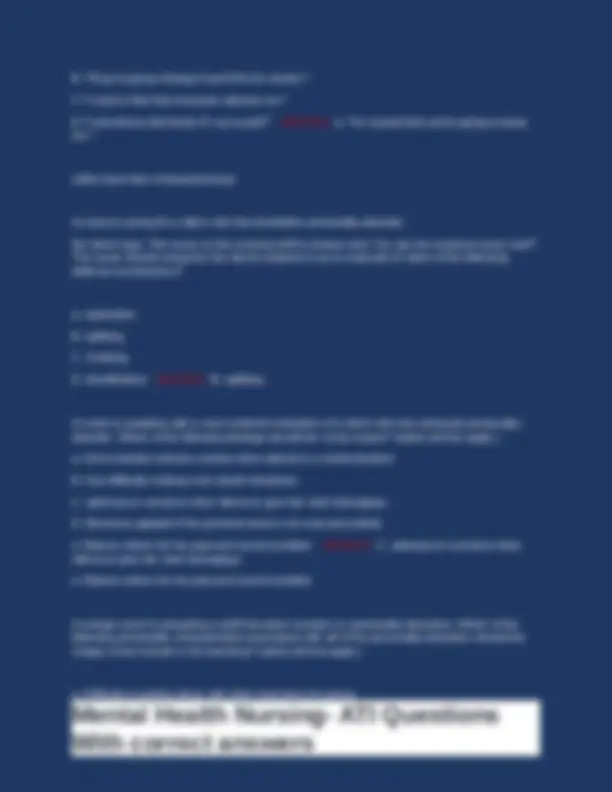
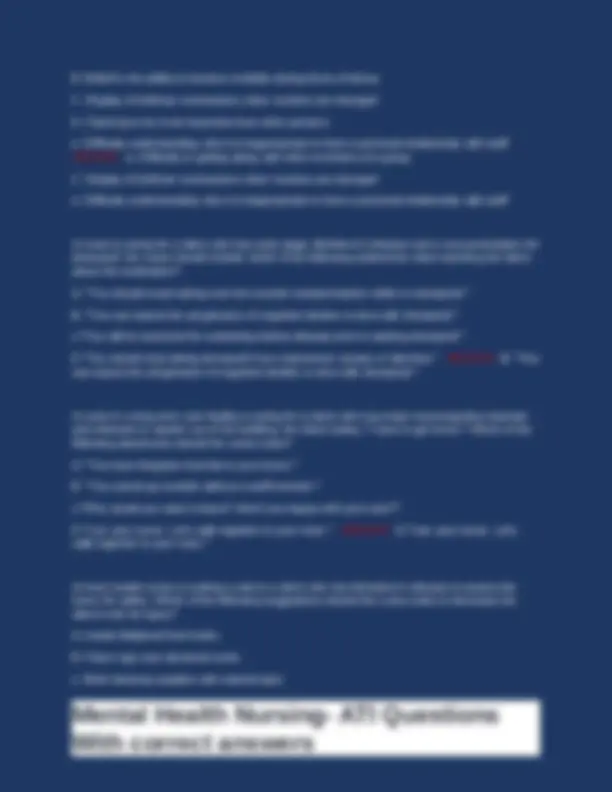
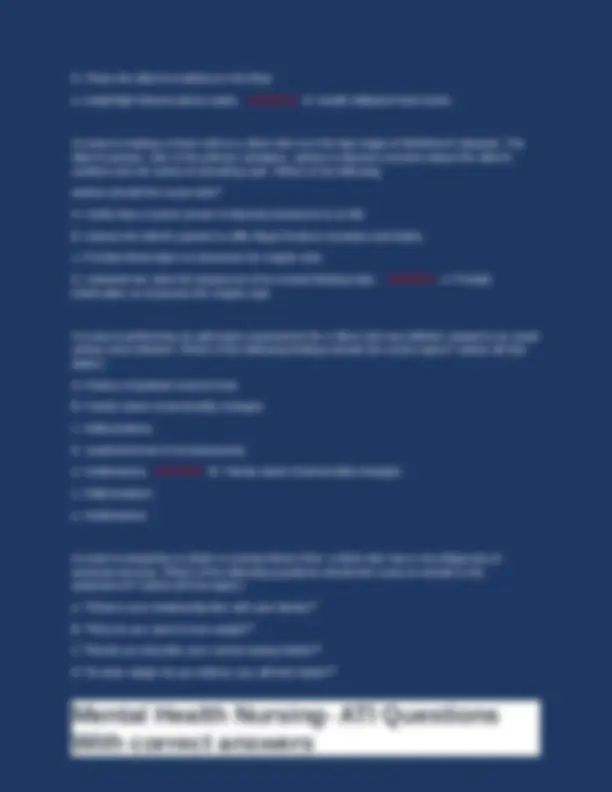
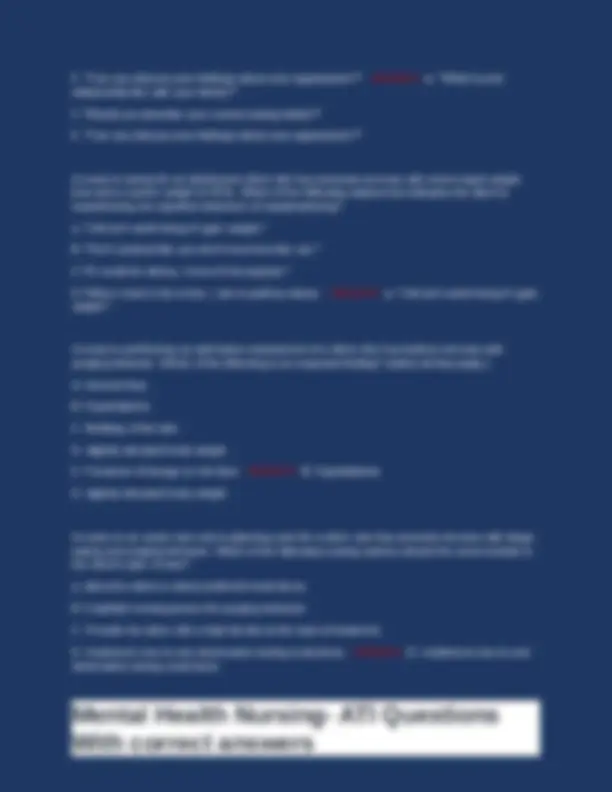
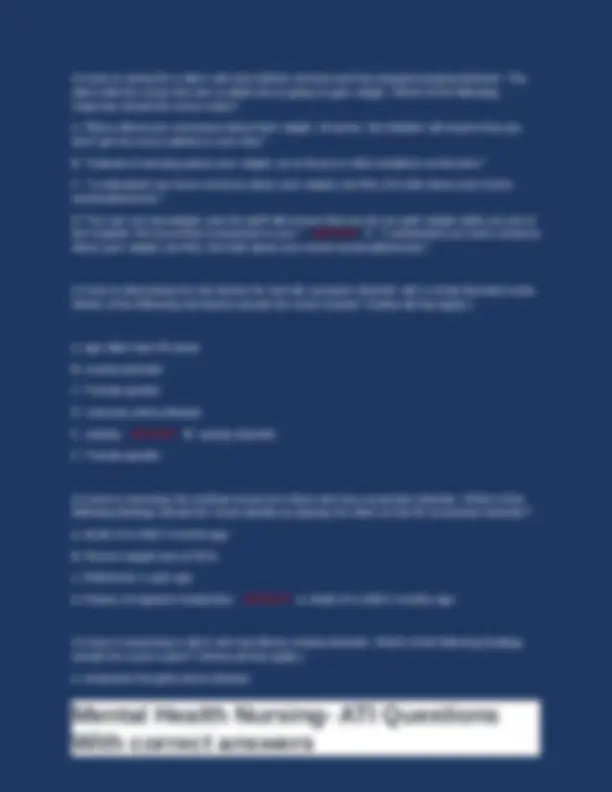
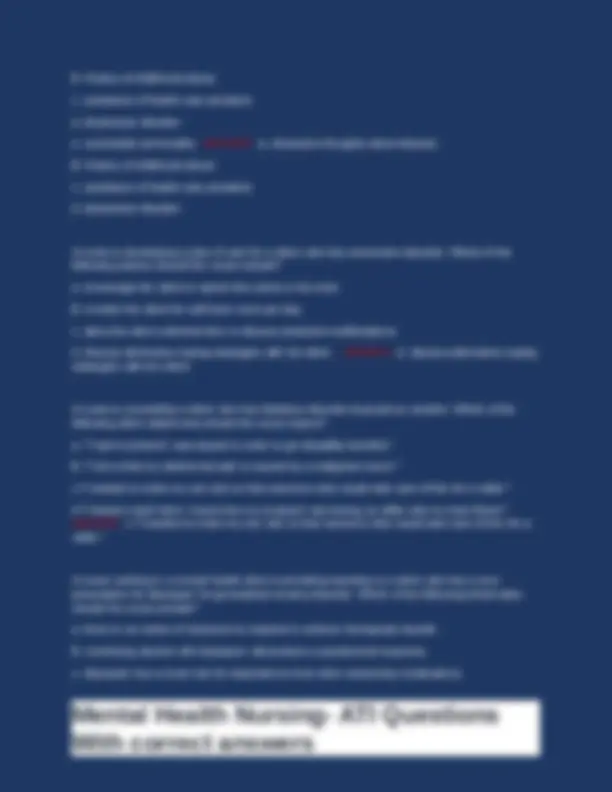
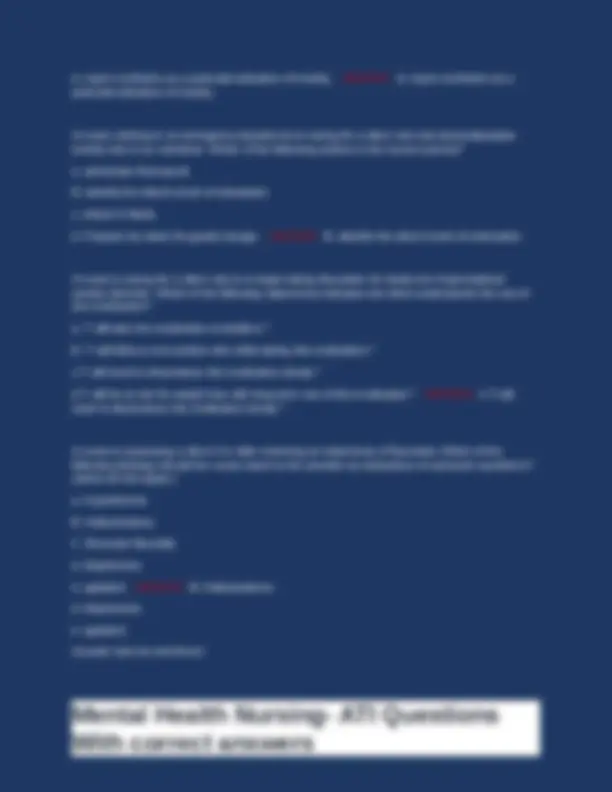
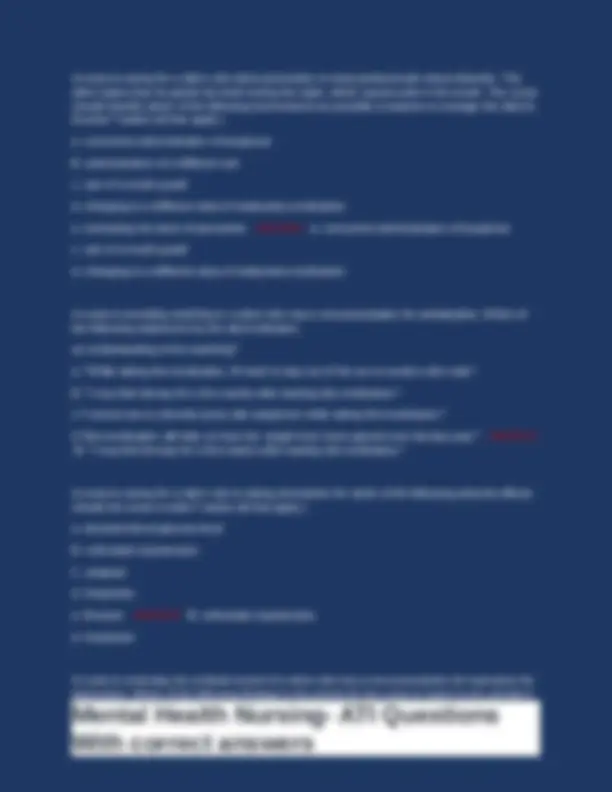
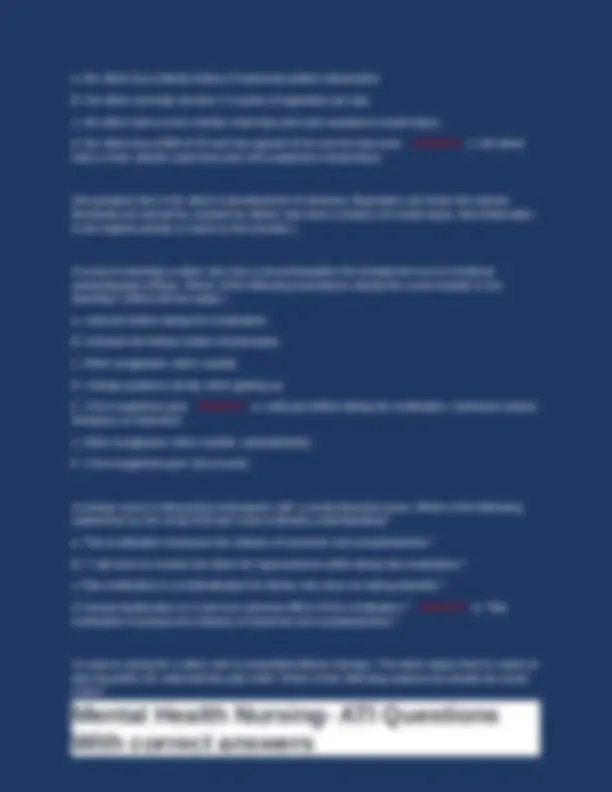
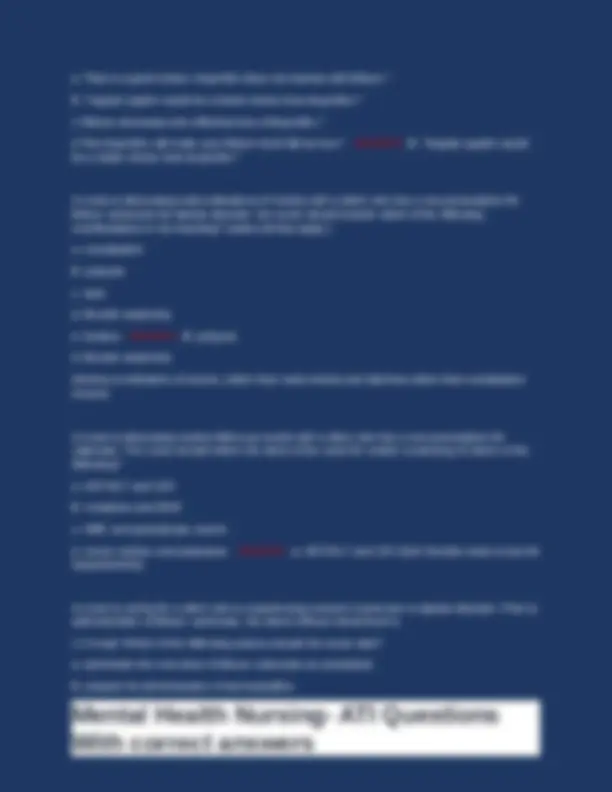
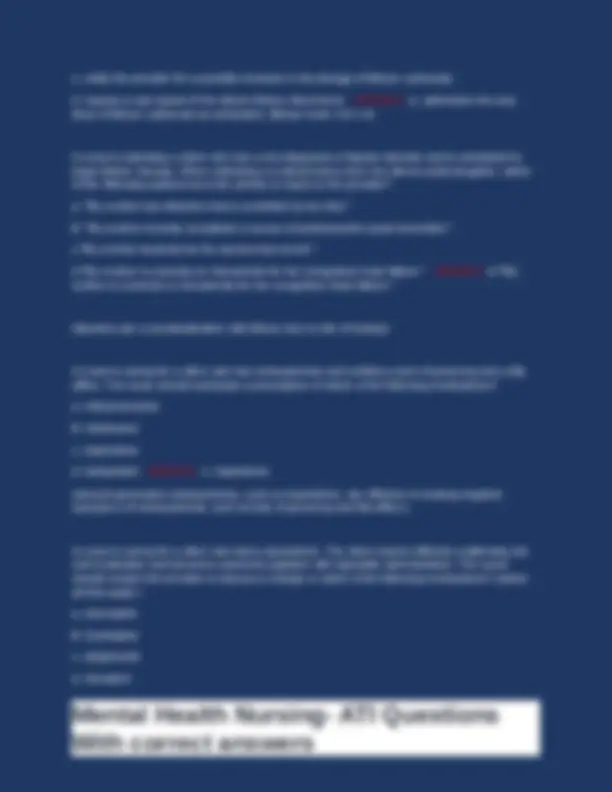
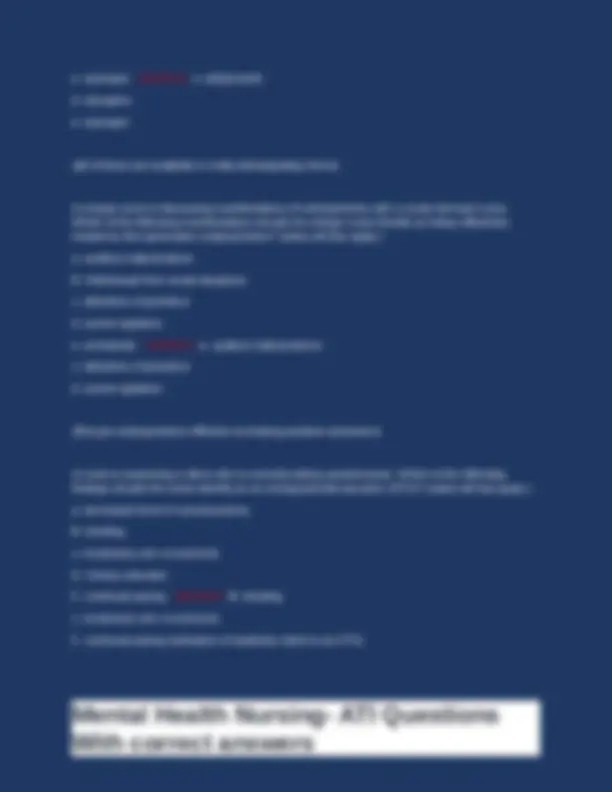
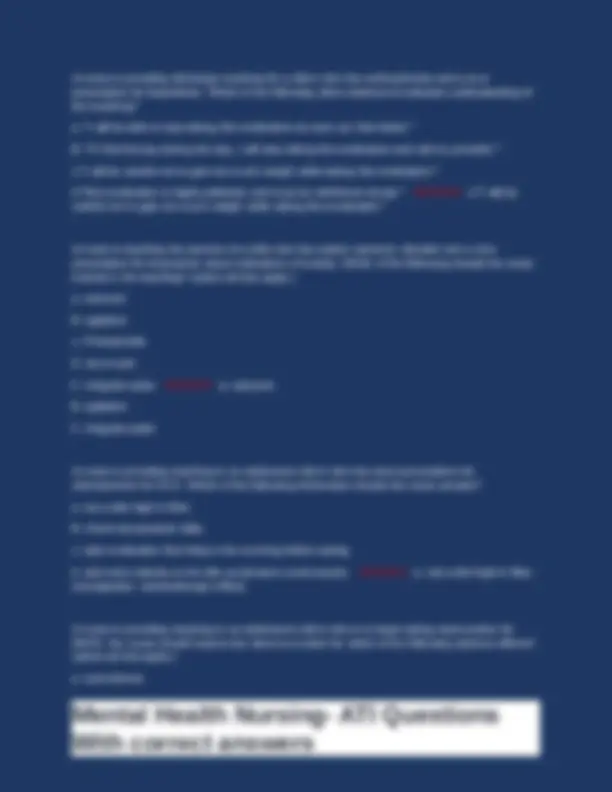
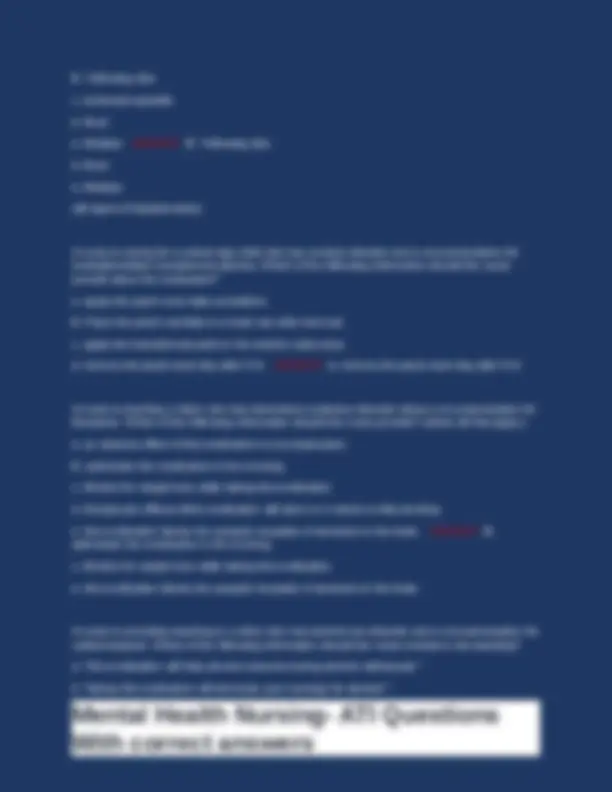
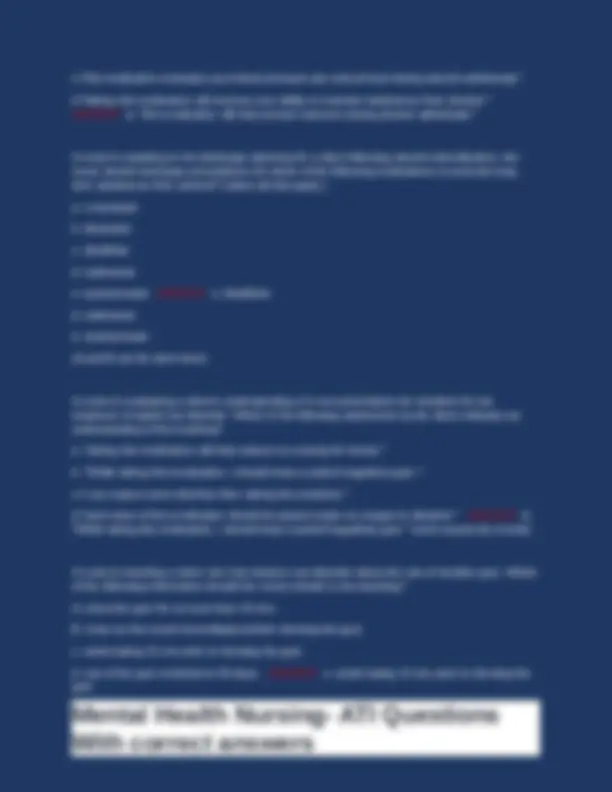
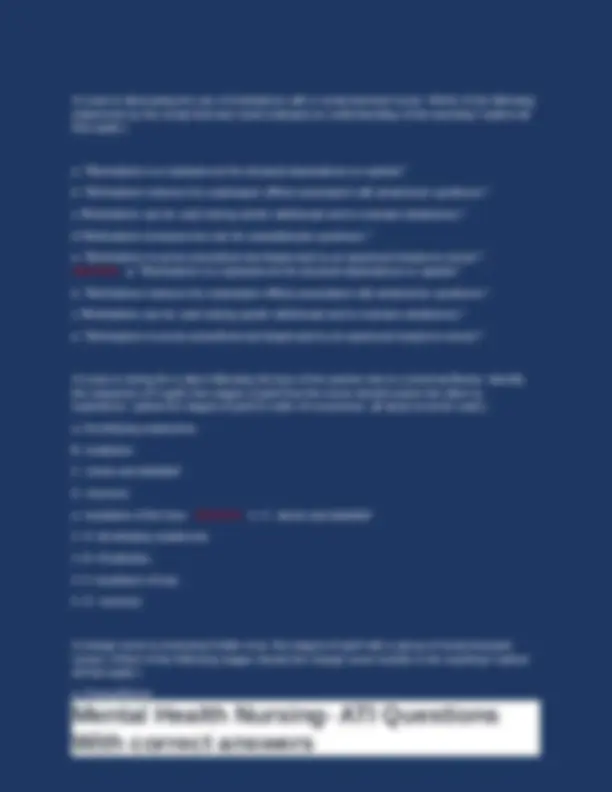
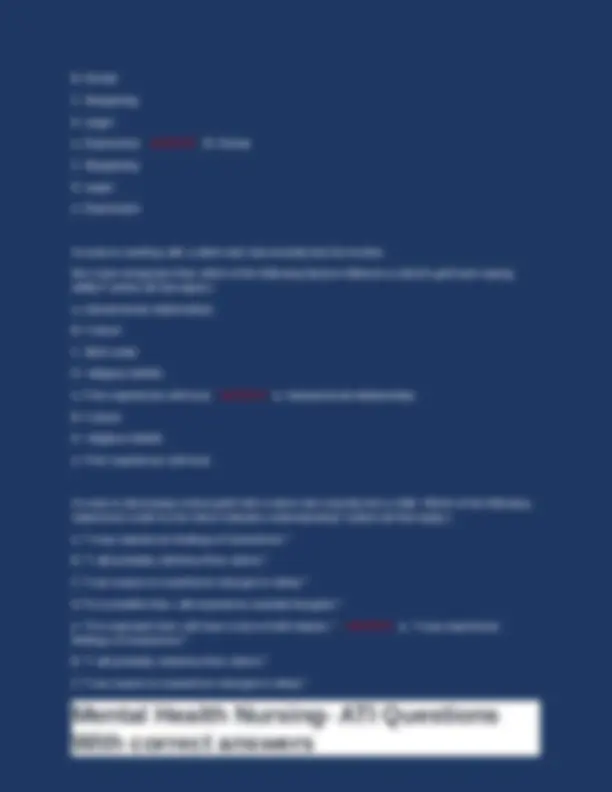
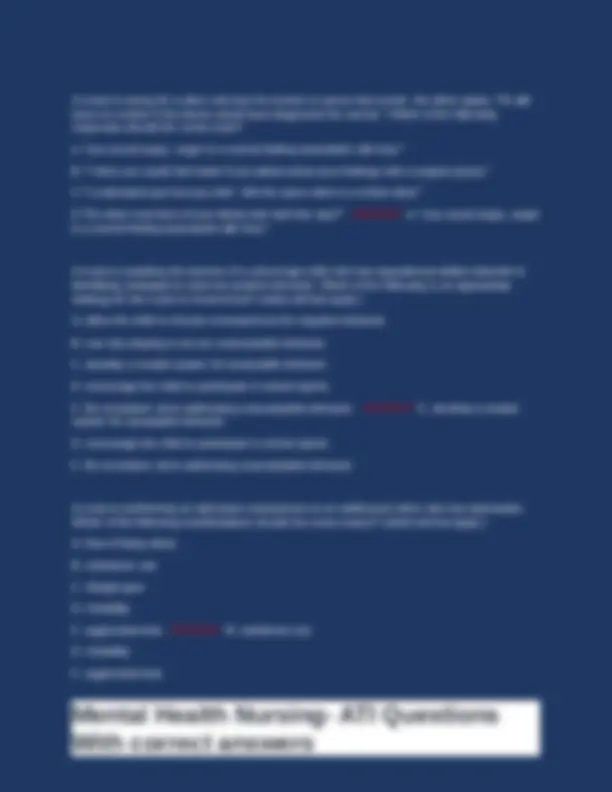
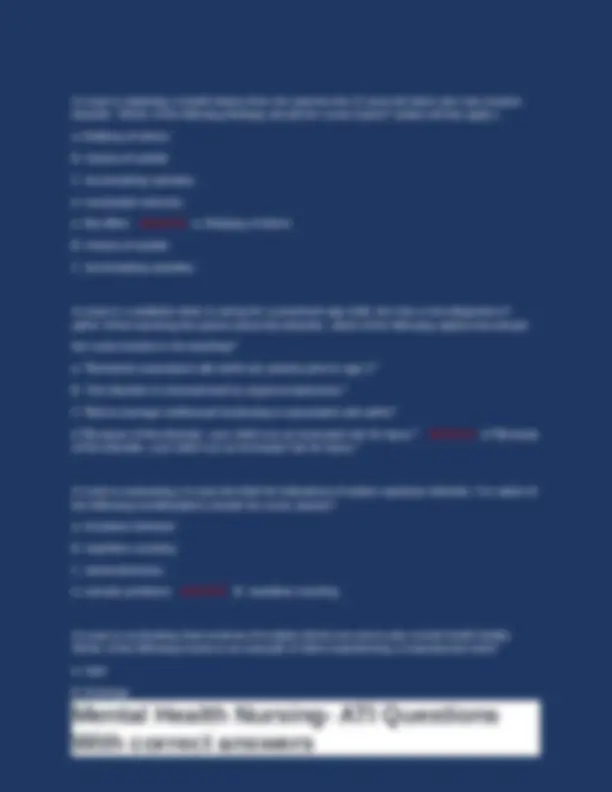
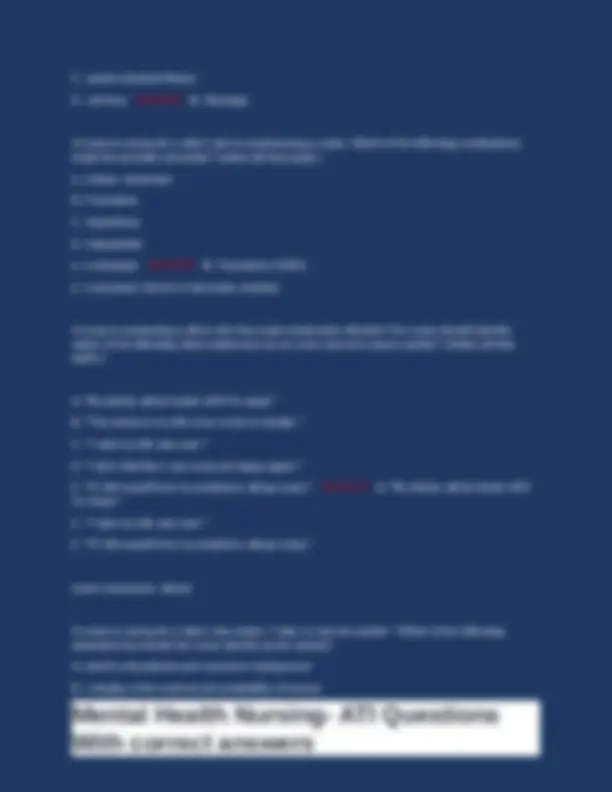
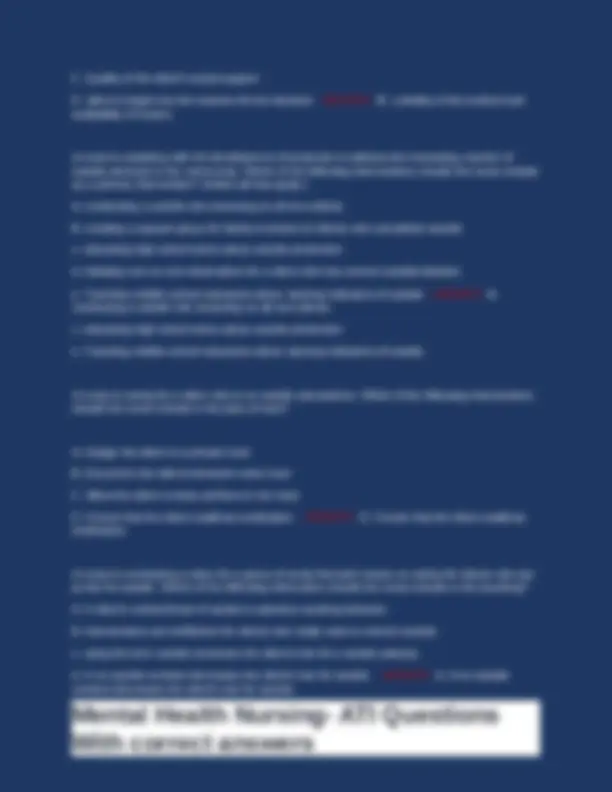
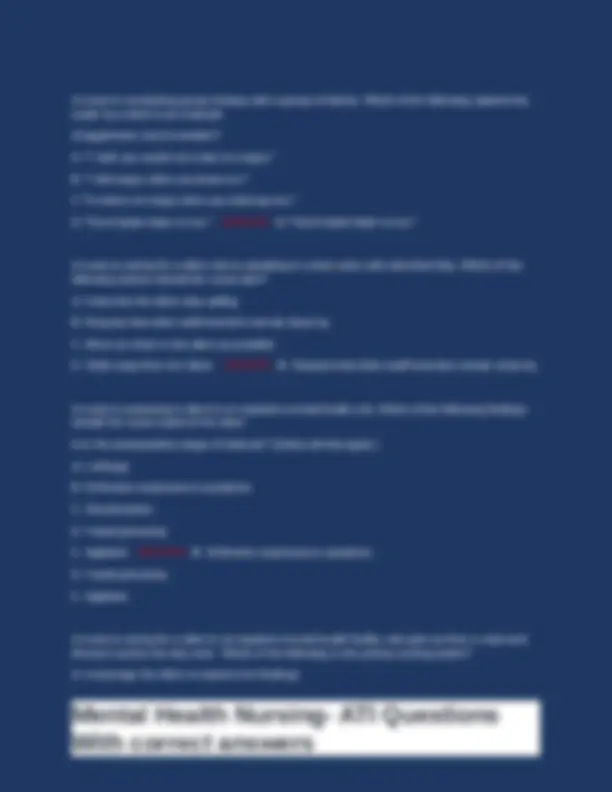
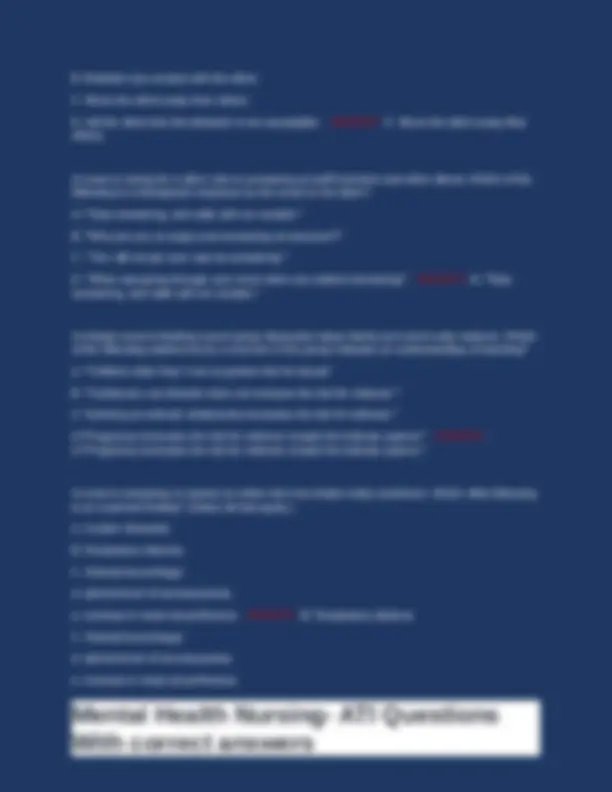
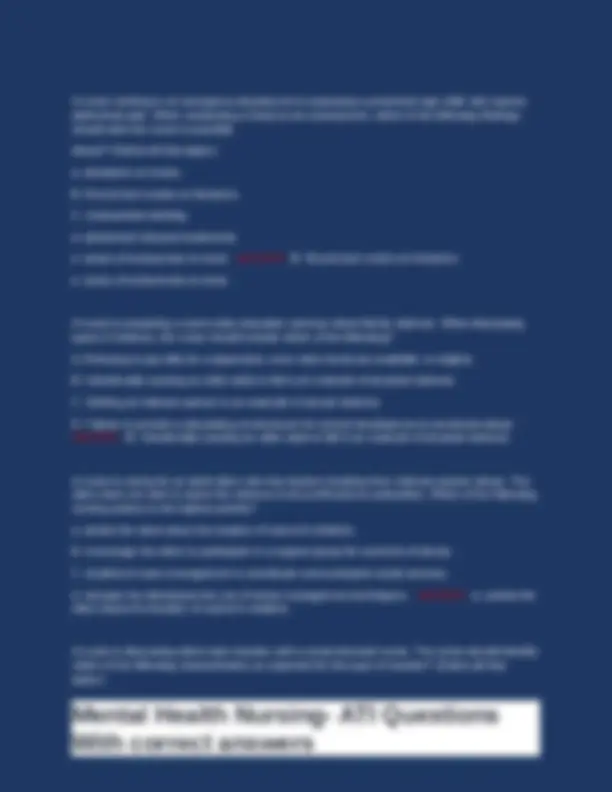
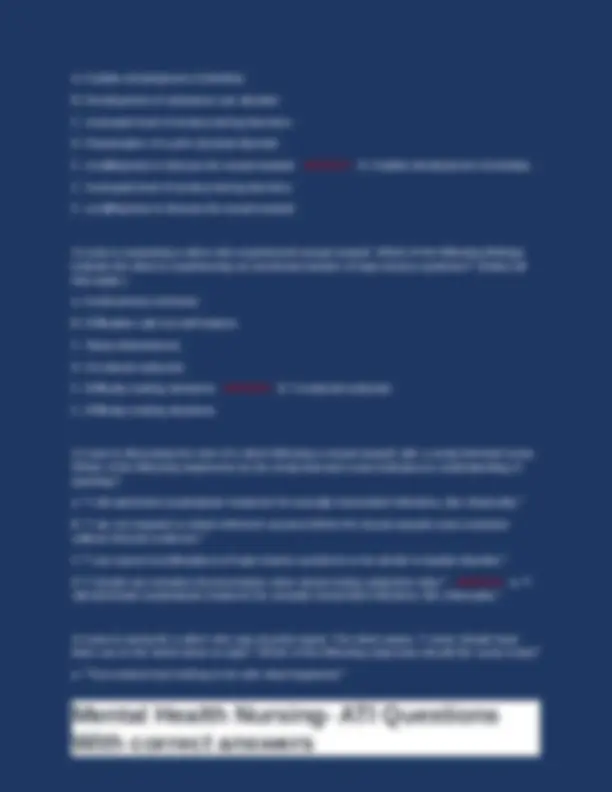
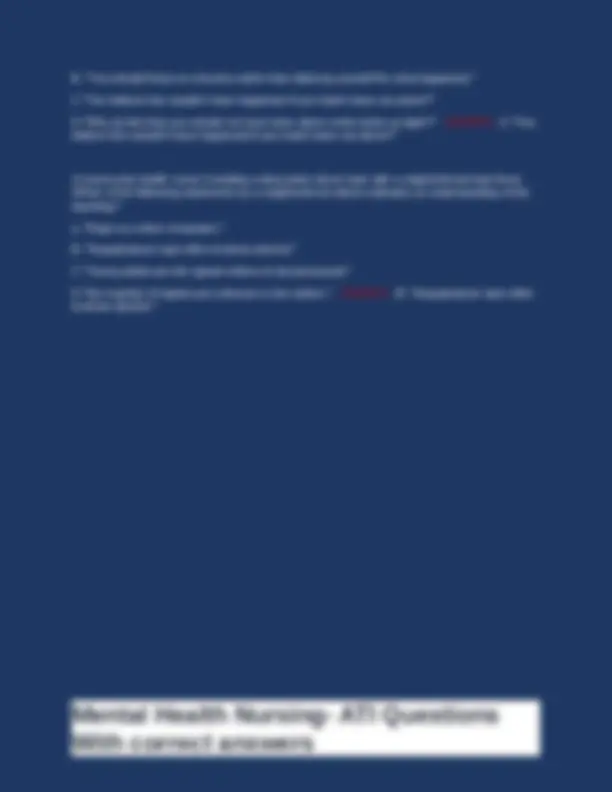


Study with the several resources on Docsity

Earn points by helping other students or get them with a premium plan


Prepare for your exams
Study with the several resources on Docsity

Earn points to download
Earn points by helping other students or get them with a premium plan
Community
Ask the community for help and clear up your study doubts
Discover the best universities in your country according to Docsity users
Free resources
Download our free guides on studying techniques, anxiety management strategies, and thesis advice from Docsity tutors
A collection of multiple-choice questions and answers related to mental health nursing, covering topics such as mental status examinations, psychobiological interventions, therapeutic communication, and client care in various settings. It is a valuable resource for students and professionals seeking to enhance their knowledge and understanding of mental health nursing principles and practices.
Typology: Exams
1 / 51

This page cannot be seen from the preview
Don't miss anything!












































A charge nurse is discussing mental status examinations with a newly licensed nurse. Which of the following statements by the newly licensed nurse indicates an understanding of the teaching? (select all that apply.) A. "to assess cognitive ability,i should ask the client to count backward by sevens." B. "to assess affect, i should observe the client's facial expression." C. "to assess language ability, i should instruct the client to write a sentence." D. "to assess remote memory, i should have the client repeat a list of objects." E. "to assess the client's abstract thinking, i should ask the client to identify our most recent presidents." - ANSWER -A. "to assess cognitive ability,i should ask the client to count backward by sevens." B. "to assess affect, i should observe the client's facial expression." C. "to assess language ability, i should instruct the client to write a sentence." A nurse is planning care for a client who has a mental health disorder. Which of the following actions should the nurse include as a psychobiological intervention? A. assist the client with systematic desensitization therapy. B. teach the client appropriate coping mechanisms. C. assess the client for comorbid health conditions. D. Monitor the client for adverse effects of medications. - ANSWER -D. Monitor the client for adverse effects of medications. (Not C bc assessing for comorbid health conditions is health promotion and maintenance, rather than a psychobiological, intervention)
A nurse in an outpatient mental health clinic is preparing to conduct an initial client interview. When conducting the interview, which of the following actions should the nurse identify as the priority? a. coordinate holistic care with social services. B. identify the client's perception of her mental health status. c. include the client's family in the interview. D. teach the client about her current mental health disorder. - ANSWER -B. identify the client's perception of her mental health status. A nurse is told during change‐of‐shift report that a client is stuporous. When assessing the client,which of the following findings should the nurse expect? a. the client arouses briefly in response to a sternal rub. B. the client has a glasgow coma scale score less than 7. c. the client exhibits decorticate rigidity. D. the client is alert but disoriented to time and place. - ANSWER -a. the client arouses briefly in response to a sternal rub. A nurse is planning a peer group discussion about the Diagnostic and Statistical Manual of Mental Disorders, 5th edition (DsM‐5). Which of the following information is appropriate to include in the discussion? (select all that apply.) a. the DsM‐5 includes client education handouts for mental health disorders. B. the DsM‐5 establishes diagnostic criteria for individual mental health disorders. c. the DsM‐5 indicates recommended pharmacological treatment for mental health disorders. D. the DsM‐5 assists nurses in planning care for client's who have mental health disorders. e. the DsM‐5 indicates expected assessment findings of mental health disorders. - ANSWER -B. the DsM‐5 establishes diagnostic criteria for individual mental health disorders. D. the DsM‐5 assists nurses in planning care for client's who have mental health disorders.
d. Report the incident to the health care team, but do not inform the client of the intention to do so. - ANSWER -c. Tell the client that this must be reported to the health care team because it concerns the health and safety of the client and others. A nurse is caring for a client who is in mechanical restraints. Which of the following statements should the nurse include in the documentation? (select all that apply.) A. "Client ate most of his breakfast." B. "Client was offered 8 oz of water every hr." C. "Client shouted obscenities at assistive personnel." D. "Client received chlorpromazine 15 mg by mouth at 1000." E. "Client acted out after lunch." - ANSWER -B. "Client was offered 8 oz of water every hr." C. "Client shouted obscenities at assistive personnel." D. "Client received chlorpromazine 15 mg by mouth at 1000." A nurse hears a newly licensed nurse discussing a client's hallucinationsin the hallway with another nurse. Which of the following actions should the nurse take first? A. Notify the nurse manager. B. Tell the nurse to stop discussing the behavior. C. Provide an in‐service program about confidentiality. D. Complete an incident report. - ANSWER -B. Tell the nurse to stop discussing the behavior. A charge nurse is conducting a class on therapeutic communication toa group of newly licensed nurses. Which of the following aspects of communication should the nurse identify as a component of verbal communication? a. Personal space B. Posture C. Eye contact
D. intonation - ANSWER -D. intonation A nurse in an acute mental health facility is communicating with a client. the client states, "I can't sleep. I stay up all night." the nurse responds, "You are having difficulty sleeping?" Which of the following therapeutic communication techniques is the nurse demonstrating? a. Offering general leads B. Summarizing C. Focusing D. Restating - ANSWER -D. Restating A nurse is communicating with a client who was just admitted for treatment of a substance use disorder. Which of the following communication techniques should the nurse identify as a barrier to therapeutic communication? A. Offering advice B. Reflecting C. Listening attentively D. Giving information - ANSWER -A. Offering advice A nurse caring for a client who has anorexia nervosa. Which of the following examples demonstrates the nurse's use of interpersonal communication? A. The nurse discusses the client's weight loss during a health care team meeting. B. The nurse examines her own personal feelings about clients who have anorexia nervosa. C. The nurse asks the client about her body image perception. D. The nurse presents an educational session about anorexia nervosa to a large group of adolescents. - ANSWER -C. The nurse asks the client about her body image perception. A nurse is caring for the parents of a child who has demonstrated recent changes in behavior and mood. When the mother of the child asks the nurse for reassurance about her son's condition, which of the following responses should the nurse make?
C. Ignore the client's anxiety so that she will not be embarrassed. D. Demonstrate a calm manner while using simple and clear directions. E. Gather informationfrom the client using closed‐ended questions. - ANSWER -B. Discuss prior use of coping mechanisms with the client. D. Demonstrate a calm manner while using simple and clear directions. A nurse is talking with a client who is at risk for suicide following the death of his spouse. Which of the following statements should the nurse make? A. "I feel very sorry for the loneliness you must be experiencing." B. "Suicide is not the appropriate way to cope with loss." C."Losing someone close to you must be very upsetting." D. "I know how difficult it is to lose a loved one." - ANSWER -C."Losing someone close to you must be very upsetting." A charge nurse is discussing the characteristics of a nurse-client relationship with a newly licensed nurse. Which of the following characteristics should the nurse include in the discussion? (Select all that apply.) A. The needs of both participants are met. B. An emotional commitment exists between the participants. C. It is goal-directed. D. Behavioral change is encouraged. E. A termination date is established. - ANSWER -C. It is goal-directed. D. Behavioral change is encouraged. E. A termination date is established. A nurse is in the working phase of a therapeutic relationship with a client who has methamphetamine use disorder. Which of the following actions indicates transference behavior?
A. The client asks the nurse whether she will go out to dinner with him. B. The client accuses the nurse of telling him what to do just like his ex-girlfriend. C. The client reminds the nurse of a friend who died from a substance overdose. D. The client becomes angry and threatens harm to himself - ANSWER -B. The client accuses the nurse of telling him what to do just like his ex-girlfriend. A nurse is planning care for the termination phase of a nurse-client relationship. Which of the following actions should the nurse include in the plan of care? A. Discussing ways to use new behaviors B. Practicing new problem-solving skills C. Developing goals D. Establishing boundaries - ANSWER -A. Discussing ways to use new behaviors A nurse is orienting a new client to a mental health unit. When explaining the unit's community meetings, which of the following statements should the nurse make? A. "You and a group of other clients will meet to discuss your treatment plans." B. "Community meetings have a specific agenda that is established by staff." C. "You and the other clients will meet with staff to discuss common problems." D. "Community meetings are an excellent opportunity to explore your personal mental health issues." - ANSWER -C. "You and the other clients will meet with staff to discuss common problems." A nurse is caring for several clients who are attending community‐based mental health programs. Which of the following clients should the nurse plan to visit first? A. A client who recently burned her arm while using a hot iron at home B. A client who requests that her antipsychotic medication be changed due to some new adverse effects C. A client who says he is hearing a voice that tells him he is not worthy of living anymore
A. Receiving daily care from a home health aide B. Having a weekly visit from a nurse case worker C. Attending a partial hospitalization program D. Visiting a community mental health center on a daily basis - ANSWER -C. Attending a partial hospitalization program A nurse is caring for a group of clients. Which of the following clients should a nurse consider for referral to an assertive community treatment (ACT) group? A. A client in an acute care mental health facility who has fallen several times while running down the hallway B. A client who lives at home and keeps "forgetting" to come in for his monthly antipsychotic injection for schizophrenia C. A client in a day treatment program who says he is becoming more anxious during group therapy D. A client in a weekly grief support group who says she still misses her deceased husband who has been dead for 3 months - ANSWER -B. A client who lives at home and keeps "forgetting" to come in for his monthly antipsychotic injection for schizophrenia (An ACT group works with clients who are nonadherent with traditional therapy, such as the client in a home setting who keeps "forgetting" his injection.) A nurse is teaching a client who has an anxiety disorder and is scheduled to begin classical psychoanalysis. Which of the following client statements indicates an understanding of this form of therapy? A. "Even if my anxiety improves, I will need to continue this therapy for 6 weeks." B. "The therapist will focus on my past relationships during our sessions."
C. "Psychoanalysis will help me reduce my anxiety by changing my behaviors." D. "This therapy will address my conscious feelings about stressful experiences." - ANSWER - B. "The therapist will focus on my past relationships during our sessions." A nurse is discussing free association as a therapeutic tool with a client who has major depressive disorder. Which of the following client statements indicates understanding of this technique? A. "I will write down my dreams as soon as i wake up." B. "I may begin to associate my therapist with important people in my life." C. "I can learn to express myself in a nonaggressive manner." D. "I should say the first thing that comes to my mind." - ANSWER -D. "I should say the first thing that comes to my mind." (Free association is the spontaneous, uncensored verbalization of whatever comes to a client's mind.) A nurse is preparing to implement cognitive reframing techniques for a client who has an anxiety disorder. Which of the following techniques should the nurse include in the plan of care? (select all that apply.) A. Priority restructuring B. Monitoring thoughts C. Diaphragmatic breathing D. Journal keeping E. Meditation - ANSWER -A. Priority restructuring B. Monitoring thoughts D. Journal keeping (Not E bc meditation is behavioral)
a. encourage the group to work toward goals. B. define the purpose of the group. C. discuss termination of the group. d. identify informal roles of members within the group. e. establish an expectation of confidentiality within the group. - ANSWER -B. define the purpose of the group. C. discuss termination of the group. e. establish an expectation of confidentiality within the group. A nurse working on an acute mental health unit forms a group to focus on self‐management of medications. At each of the meetings, two of the members use the opportunity to discuss their common interest in gambling on sports. This is an example of which of the following concepts? A. Triangulation B. Group process C. Subgroup D. Hidden agenda - ANSWER -D. Hidden agenda A nurse is conducting a family therapy session. The adolescent son tells the nurse that he plans ways to make his sister look bad so his parents will think he's the better sibling, which he believes will give him more privileges. The nurse should identify this dysfunctional behavior as which of the following? A. Placation B. Manipulation C. Blaming D. Distraction - ANSWER -B. Manipulation A nurse is working with an established group and identifies various member roles. Which of the following should the nurse identify as an individual role? A. A member who praises input from other members B. A member who follows the direction of other members C. A member who brags about accomplishments
D. A member who evaluates the group's performance toward a standard - ANSWER -C. A member who brags about accomplishments (An individual who brags about accomplishments is acting in an individual role that does not promote the progression of the group toward meeting goals.) A nurse is preparing to provide an educational seminar on stress to other nursing staff. Which of the following information should the nurse include in the discussion? a. excessive stressors cause the client to experience distress. B. the body's initial adaptive response to stress is denial. C. absence of stressors results in homeostasis. D. negative, rather than positive, stressors produce a biological response. - ANSWER -a. excessive stressors cause the client to experience distress. A nurse is discussing acute vs. prolonged stress with a client. Which of the following effects should the nurse identify as an acute stress response? (Select all that apply.) a. Chronic pain B. Depressed immune system C. Increased blood pressure D. Panic attacks E. Unhappiness - ANSWER -B. Depressed immune system C. Increased blood pressure E. Unhappiness A nurse is teaching a client about stress‐reduction techniques. Which of the followingclient statements indicates understanding of the teaching? a. "Cognitive reframing will help me change my irrational thoughts to something positive." B. "Progressive muscle relaxation uses a mechanical deviceto help me gain controlover my pulse rate."
a. "it is common to treat depression with ECT before trying medications." B. "I can have my depression cured if i receive a series of ECT treatments." C."I should receive ECT once a week for 6 weeks." D. "I will receive a muscle relaxant to protect me from injury during ECT." - ANSWER -D. "I will receive a muscle relaxant to protect me from injury during ECT." A charge nurse is discussing TMD with a newly licensed nurse. Which of the following statements by the newly licensed nurse indicates an understanding of the teaching? a. "TMS is indicated for clients who have schizophrenia spectrum disorders." B. "I will provide postanesthesia care following TMS." C."TMS treatments usually last 5 to 10 minutes." D. "I will schedule the client for daily TMS treatments for the first several weeks." - ANSWER -D. "I will schedule the client for daily TMS treatments for the first several weeks." (TMS is indicated for the treatment of major depressive disorder that is not responsive to pharmacological treatment. ECT is indicated for the treatment of schizophrenia spectrum disorders.) A nurse is assessing a client immediately following an ECT procedure. Which of the following findings should the nurse expect? (Select all that apply.) A. hypotension B. paralytic ileus C. memory loss D. nausea E. Confusion - ANSWER -C. memory loss D. nausea E. Confusion A nurse is leading a peer group discussion about the indications for ECT. Which of the following indications should the nurse include in the discussion? a. Borderline personality disorder
B. acute withdrawal related to a substance use disorder C. Bipolar disorder with rapid cycling D. Dysphoric disorder - ANSWER -C. Bipolar disorder with rapid cycling A nurse is planning care for a client following surgical implantation of a VnS device. the nurse should planto monitor for which of the following adverse effects? (Select all that apply.) a. Voice changes B. Seizure activity C. Disorientation D. Dysphagia e. neck pain - ANSWER -a. Voice changes D. Dysphagia e. neck pain A nurse observes a client who has OCD repeatedly applying, removing, and then reapplying makeup. The nurse identifies that repetitive behavior in a client who has OCD is due to which of the following underlying reasons? A. narcissistic behavior B. Fear of rejection from staff C. Attempt to reduce anxiety D. Adverse effect of antidepressant medication - ANSWER -C. Attempt to reduce anxiety A nurse is caring for a client who is experiencing a panic attack. Which of the following actions should the nurse take? A. Discuss new relaxation techniques. B. Show the client how to change his behavior. C. Distract the client with a television show. D. Stay with the client and remain quiet. - ANSWER -D. Stay with the client and remain quiet.
A nurse working on an acute mental health unit is caring for a client who has posttraumatic stress disorder (PTSD). Which of the following findings should the nurse expect? (Select all that apply.) A. Difficulty concentrating on tasks B. Obsessive need to talk about the traumatic event C. Negative self‐image D. Recurring nightmares E. Diminished reflexes - ANSWER -A. Difficulty concentrating on tasks C. Negative self‐image D. Recurring nightmares A nurse is involved in a serious and prolonged mass casualty incident in the emergency department. Which of the following strategies should the nurse use to help prevent developing a trauma‐related disorder? (Select all that apply) a. avoid thinking about the incident when it is over. B. Take breaks during the incident for food and water. C. debrief with others following the incident. d. Hold emotions in check in the days following the incident. e. Take advantage of offered counseling. - ANSWER -B. Take breaks during the incident for food and water. C. debrief with others following the incident. e. Take advantage of offered counseling. A nurse is collecting an admission history for a client who has acute stress disorder (ASD). Which of the following information should the nurse expect to collect?
a. The client remembers many details about the traumatic incident. B. The client expresses heightened elation about what is happening. C. The client states he first noticed manifestations of the disorder 6 weeks after the traumatic incident occurred. d. The client expresses a sense of unreality about the traumatic incident. - ANSWER -d. The client expresses a sense of unreality about the traumatic incident. A nurse is caring for a client who has derealization disorder. Which of the following findings should the nurse identify as an indication of derealization? a. The client explains that her body seems to be floating above the ground. B. The client has the idea that someone is trying to kill her and steal her money. C. The client states that the furniture in the room seems to be small and far away. d. The client cannot recall anything that happened during the past 2 weeks. - ANSWER -C. The client states that the furniture in the room seems to be small and far away. A nurse in an acute mental health facility is planning care for a client who has dissociative fugue. Which of the following interventions should the nurse add to the plan of care? A. Teach the client to recognize how stress brings on a personality change in the client. B. Repeatedly present the client with information about past events. C. Make decisions for the client regarding routine daily activities. D. Work with the client on grounding techniques. - ANSWER -D. Work with the client on grounding techniques. A nurse working in an acutemental health facility is caring for a 35‐year‐old female client who has manifestations of depression. The client lives at home with her partner and two young children. she currently smokes and has a history of chronic asthma. Which of the following factors put the client at risk for depression? (select all that apply.) A. Age B. Gender C. History of chronic asthma D. Smoking